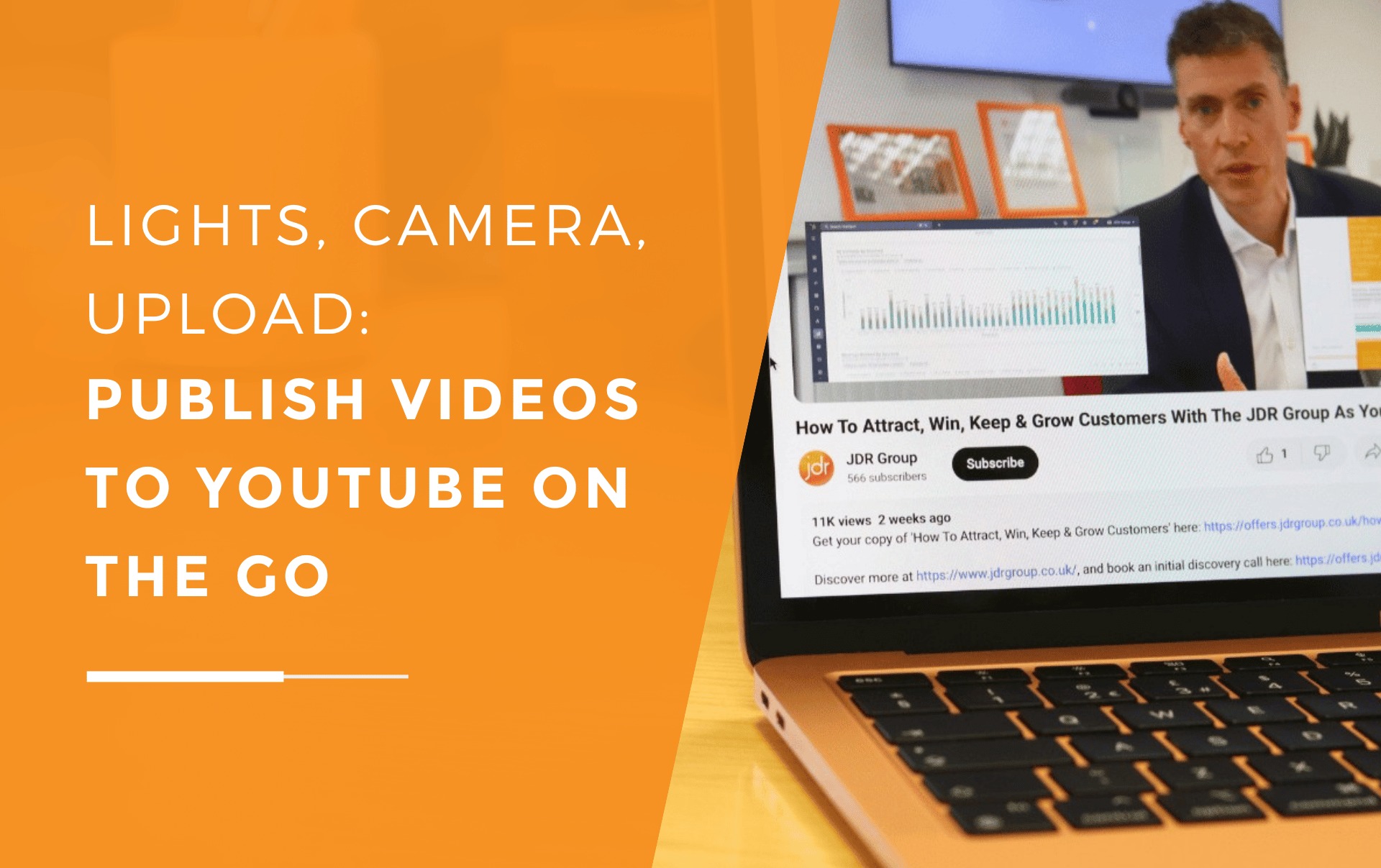What Should You Post On Your Business Social Media Platforms?
by Kerry Baker on 16-Jul-2025 09:30:00

Social media has become such a ubiquitous part of the business landscape that companies have to be extremely discerning about what they post. The most successful businesses are those who balance a thoughtful and consistent social media presence with a tailored content strategy for each platform, mixing informative written content with engaging visuals and interactive elements. In this article, we’ll look at the different types of content that work well on social media and how to develop a strategic mindset to transform social media into a strong marketing asset for your business.
1. Company News And Announcements
This is the classic way that businesses use social media – for sharing company updates and keeping your customers, suppliers, and prospects in the loop. This type of content might include product launches, upcoming campaigns, updates on project milestones, and even interesting tidbits about the community causes and charities your team might be supporting. However, this type of content is so well used that it pays to be creative. If you’re using social media to promote an upcoming seasonal campaign, for instance, you could use LinkedIn or Facebook to post a countdown, share teasers, and finally announce the launch. Include calls to action within your post to direct your customers to learn more, visit a landing page, or even to request a demo or preorder.
2. Thought Leadership And Microblogs
Business decision-makers generally look for more from the social media accounts they follow than an endless wall of memes and updates. They also value succinct and insightful content about a range of issues. Social media platforms aren’t generally suited to lengthy posts, but short opinion pieces or microblogs are a good way of hooking readers and directing them to your website, blog, or other in-depth content assets. Many businesses share a bold opinion, industry insight, or concise takeaway from their blog on social media, including a backlink to the website for the full piece. This also works for your guides and longer form content. For instance, you could post a few key statistics from your latest white paper or e-book with a link to download the full (gated) document. You can also cross promote video content from YouTube by embedding short clips onto your social media accounts to boost engagement and click throughs.
3. Video Content
Social media and video content have become almost synonymous, and videos of all shapes and stripes are an excellent way to create authentic connections with your customers and engage with users on their mobile devices. And what can you do with video? Pretty much anything you can do with a blog. Showcase ongoing projects, share your customer success stories, feedback, or testimonials, comment on breaking news stories, or even broadcast updates from events in real time. In general, short form videos work best on social media (especially Facebook and Instagram). Keep your videos under two minutes if possible and include subtitles for accessibility on mobile devices – you can always go into greater depth with longer form videos on your YouTube channel.
4. Photos And Images
Visual content, including photos, images, and infographics, can be extremely impactful on social media, especially when viewed on a phone or mobile device. There are thousands of ways in which you can use photos on social media, including on-site images from projects, images of your team, snapshots from industry events, and user generated content featuring your customers or clients interacting with your projects. Images can be quickly and cheaply uploaded to your social media at any time to maintain posting consistency and keep your business in your followers feeds. However, relevancy is really important. Don’t just post for the sake of it – images should be genuinely relevant, original, and of a decent resolution and image quality. We recommend avoiding using stock photos and AI-generated images on your social media accounts, as these can come across as generic and could put off customers.
5. Shared Content
Your social media platforms aren’t simply a platform for your own content, but can also be used as a means of sharing relevant and value driven content from other users. If you come across a relevant blog, infographic, or report, feel free to share it with your own followers, together with any relevant comments. This is a good way of building relationships with suppliers and influencers in your industry and also cementing your reputation as an authority and thought leader by adding your unique perspective in the caption. Be careful, however, that any content you share aligns with your company’s values and objectives, and always give full credit to the original content creator. A word of caution about sharing content, too: we’ve all seen social media accounts that lean too heavily on shared content, so use the 80/20 rule to strike a good balance. 80% of your posts should, ideally, be unique, branded content that showcases your company’s expertise, products, services, or company culture, while 20% can be curated shared content from other industry partners, stakeholders, and leaders.
6. Polls And Surveys
And finally, don’t be afraid to get interactive with your social media content. Ideally, a social media marketing strategy should be an active conversation between your business and its customers, and not a one-way monologue. Social media polls, for instance, are a great interactive way to collect insights from your customers and to stimulate engagement, and can also provide ideas for future content creation. You could, for example, ask your LinkedIn followers about their opinion on the biggest challenges facing their team regarding automated manufacturing processes, or any other subject relevant to your audience and your value proposition. These challenges could then be addressed individually in a series of blog articles, linked to a guide that covers the matter in greater depth and angles your business as the ideal solution.
Download Our Free ‘Social Media Marketing For Businesses’ Guide
Content strategy and more are covered in our informative new guide: Social Media Marketing For Businesses. Claim your free copy today by clicking here.
- Inbound Marketing (SEO, PPC, Social Media, Video) (819)
- Strategy (360)
- Sales & CRM (191)
- Marketing Automation & Email Marketing (190)
- Business Growth (161)
- Website Design (160)
- Hubspot (136)
- Lead Generation (113)
- Google Adwords (98)
- Content Marketing (94)
- Case Studies (47)
- News (47)
- Conversion (44)
- Ecommerce (38)
- Webinars (33)
- SEO (24)
- AI (19)
- Events (19)
- Video (17)
- LinkedIn Advertising (15)
- Video Selling (15)
- Software training (13)
- Niche business marketing (11)
- The Digital Prosperity Podcast (10)
- Facebook Advertising (6)
- HubSpot Case Studies (5)
- November 2025 (6)
- October 2025 (17)
- September 2025 (16)
- August 2025 (14)
- July 2025 (14)
- June 2025 (5)
- May 2025 (19)
- April 2025 (15)
- March 2025 (13)
- February 2025 (13)
- January 2025 (8)
- December 2024 (2)
- November 2024 (4)
- October 2024 (21)
- September 2024 (4)
- August 2024 (8)
- July 2024 (14)
- June 2024 (16)
- May 2024 (25)
- April 2024 (15)
- March 2024 (18)
- February 2024 (5)
- January 2024 (10)
- December 2023 (6)
- November 2023 (10)
- October 2023 (13)
- September 2023 (12)
- August 2023 (14)
- July 2023 (13)
- June 2023 (14)
- May 2023 (15)
- April 2023 (13)
- March 2023 (14)
- February 2023 (13)
- January 2023 (15)
- December 2022 (13)
- November 2022 (6)
- October 2022 (8)
- September 2022 (22)
- August 2022 (15)
- July 2022 (13)
- June 2022 (16)
- May 2022 (14)
- April 2022 (16)
- March 2022 (17)
- February 2022 (11)
- January 2022 (8)
- December 2021 (6)
- November 2021 (7)
- October 2021 (11)
- September 2021 (10)
- August 2021 (7)
- July 2021 (7)
- June 2021 (4)
- May 2021 (4)
- April 2021 (1)
- March 2021 (3)
- February 2021 (5)
- January 2021 (4)
- December 2020 (7)
- November 2020 (6)
- October 2020 (5)
- September 2020 (9)
- August 2020 (18)
- July 2020 (17)
- June 2020 (17)
- May 2020 (10)
- April 2020 (21)
- March 2020 (24)
- February 2020 (21)
- January 2020 (12)
- December 2019 (23)
- November 2019 (12)
- October 2019 (14)
- September 2019 (16)
- August 2019 (15)
- July 2019 (13)
- June 2019 (6)
- May 2019 (8)
- April 2019 (4)
- March 2019 (2)
- February 2019 (2)
- January 2019 (2)
- December 2018 (3)
- November 2018 (24)
- September 2018 (11)
- August 2018 (9)
- June 2018 (3)
- May 2018 (6)
- April 2018 (14)
- March 2018 (12)
- February 2018 (16)
- January 2018 (15)
- December 2017 (15)
- November 2017 (18)
- October 2017 (23)
- September 2017 (19)
- August 2017 (28)
- July 2017 (27)
- June 2017 (25)
- May 2017 (18)
- April 2017 (17)
- March 2017 (16)
- February 2017 (17)
- January 2017 (14)
- December 2016 (21)
- November 2016 (27)
- October 2016 (25)
- September 2016 (16)
- August 2016 (20)
- July 2016 (19)
- June 2016 (14)
- May 2016 (20)
- April 2016 (24)
- March 2016 (22)
- February 2016 (28)
- January 2016 (27)
- December 2015 (28)
- November 2015 (19)
- October 2015 (9)
- September 2015 (12)
- August 2015 (5)
- July 2015 (1)
- June 2015 (10)
- May 2015 (3)
- April 2015 (11)
- March 2015 (14)
- February 2015 (15)
- January 2015 (12)
- December 2014 (2)
- November 2014 (23)
- October 2014 (2)
- September 2014 (2)
- August 2014 (2)
- July 2014 (2)
- June 2014 (7)
- May 2014 (14)
- April 2014 (14)
- March 2014 (7)
- February 2014 (2)
- January 2014 (7)
- December 2013 (9)
- November 2013 (14)
- October 2013 (17)
- September 2013 (3)
- August 2013 (6)
- July 2013 (8)
- June 2013 (4)
- May 2013 (3)
- April 2013 (6)
- March 2013 (6)
- February 2013 (7)
- January 2013 (5)
- December 2012 (3)
- November 2012 (2)
- September 2012 (1)
Subscribe by email
You May Also Like
These Related Blogs

How To Use Video Content To Boost Your Social Media Presence
The popularity of video content has been driven by mobile devices and social media, and today, thousands of UK businesses use video content to connect …

What Content Should Construction Companies Share On Social Media?
Stuck for ideas about what to post on your construction business social media accounts? Look no further than the 10 ideas below to get your customers …

Hubspot Update: Publish On YouTube Directly From The Mobile App
As part of an important HubSpot update rolled out in March 2025, you can now upload and publish YouTube videos directly from the HubSpot mobile app, u …




